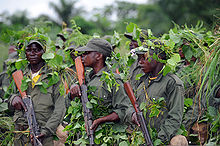Forces Armées de la République Democratique du Congo
|
|||
| guide | |||
|---|---|---|---|
| Commander in Chief : | Didier Etumba Longila (since 2008) | ||
| Military strength | |||
| Active soldiers: | 144,000–159,000 (2011) | ||
| Conscription: | |||
| Eligibility for military service: | 18-45 | ||
| Share of gross domestic product : | 1.72% (2012) | ||
| history | |||
| Founding: | 1960/2003 | ||
Forces Armées de la République Démocratique du Congo , FARDC forshort,is the name given to the armed forces of the Democratic Republic of the Congo that have existed in their current form since 2003. They emerged after the Second Congo War , when the then government forces Forces Armées Congolaises (FAC) were merged with the troops of the two major rebel movements Rassemblement congolais pour la démocratie (RCD) and Mouvement pour la Liberation du Congo (MLC).
In addition to the army , which is by far the largest branch of the armed forces, the FARDC consists of a small navy ( Marine Nationale ) and an air force ( Force Aeriene Congolaise ). Didier Etumba has been Chief of Staff of the FARDC since November 17, 2008 , after President Joseph Kabila dismissed Army Chief Dieudonne Kayembe on the same day. General François Olenga has been Chief of the Army since 2012 .
The FARDC is considered to be one of the armed forces in the world that pays its members the least wages and is the worst equipped.
history
founding
After the end of the Second Congo War, it was agreed, among other things, that new Congolese armed forces should emerge from the regular FAC and the rebel movements. The transitional constitution published on March 6, 2003 stipulated that the FAC, the RDC and two factions split off from it (RDC-N and RDC-ML), the MLC and the May-May merge to form the FARDC. It is estimated that between 130,000 and 370,000 soldiers registered for integration into the new Congolese armed forces
In 2006 only 6 of the planned 18 brigades were formed. Internationally it was feared that the FARDC would dissolve before the reconstruction was completed.
organization
In 2011, the FARDC consisted of approximately 144,000 to 159,000 members of the armed forces. She continues to suffer from organizational and logistical problems. The soldiers are inadequately trained and equipped, their wages are only paid out irregularly and are usually barely enough to make a living.
The rebuilding of the army is ongoing. That is why attempts have been made for years to reform the FARDC. Units of the FARDC are trained and logistically supported by UN units .
activities
The FARDC achieved its greatest success in November 2013, when the rebels of the movement had to admit their defeat on March 23rd .
Numerous human rights violations can be traced back to members of the FARDC. There are regular attacks on civilians, including looting and rape.
Calls
The FARDC has sent a light infantry battalion to the AU-RTF .
literature
- Dominic Johnson : Congo - Wars, Corruption and the Art of Survival. 2nd updated edition. Brandes & Apsel Verlag, 2009, ISBN 978-3-86099-743-7 .
Web links
- Armed Forces of the World: Congo Dem. Rep. GlobalDefence.net (Status: 2006)
- The World Factbook. Congo, Democratic Republic of the. CIA
Individual evidence
- ^ The World Factbook
- ↑ Government soldiers expelled in eastern Congo. dw, November 18, 2014, accessed December 6, 2014 .
- ↑ Simone Schlundwein: There is panic in the streets of Kinshasa. TAZ, December 31, 2013, accessed March 19, 2014 .
- ↑ a b c Tinko Weibezah, Sebastian Riet: A difficult way - to reform the armed forces in the DR Congo. (PDF) Konrad Adenauer Foundation, October 13, 2010, accessed on March 19, 2014 .
- ↑ a b Georges Berghezan: Forces Armées de RDC: Le chaos institutionnalisé? (PDF) January 9, 2014, accessed March 13, 2014 .
- ↑ Dominic Johnson: EU scouts in the Congo. TAZ, January 26, 2006, accessed March 19, 2014 .
- ↑ Dominic Johnson: Kabila saved. What about the Congo? TAZ, November 11, 2013, accessed March 19, 2014 .
- ↑ DR Congo: initial findings by UN confirm human rights violations amid recent violence. UN News Center, December 18, 2012, accessed March 19, 2014 .
- ↑ La République Démocratique du Congo contribue un contingent de 500 soldiers à la Force régionale d'intervention sous la conduite de l'Union africaine pour l'élimination de l'Armée de résistance du Seigneur -African Union - Peace and Security Department. February 15, 2013, accessed April 22, 2017 (French).
